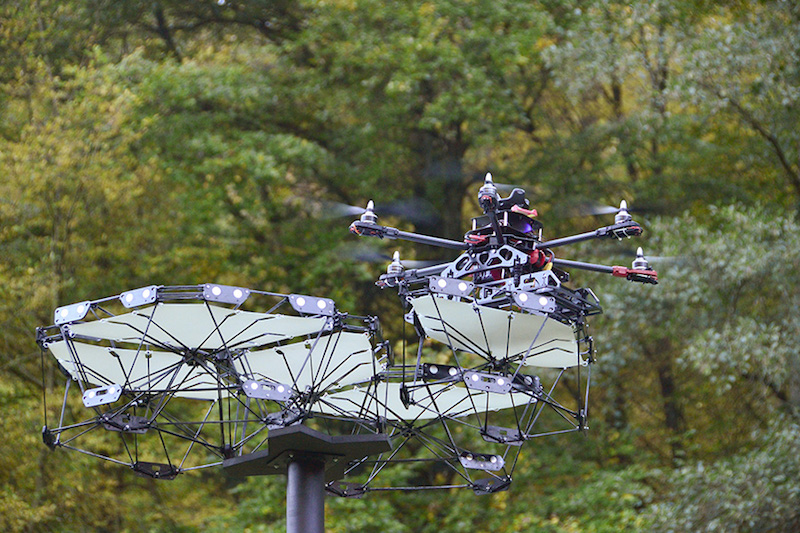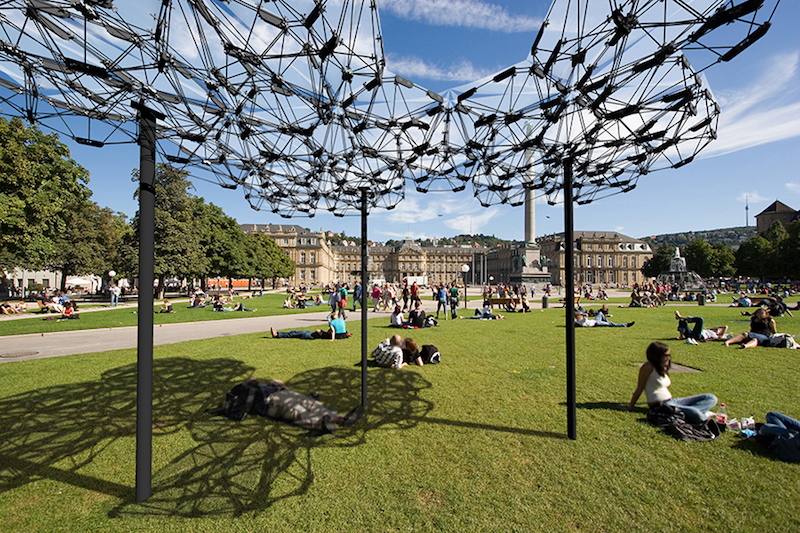Architecture is always evolving. Be it the way buildings are designed, the processes by which they are built, or the materials used. But a new prototype from the University of Stuttgart takes this continuous evolution to a new level, with a reconfigurable canopy system for public spaces that is in a state of perpetual construction.
The Cyber Physical Macro Material as a UAV [re]Configurable Architectural System (hopefully the name will continue to evolve as well) combines cyber-physical building material constructed from lightweight carbon fiber filament with integrated electronics for communication and sensing, with a collection of autonomous aerial vehicles, dubbed builders.

The canopy is composed of individual pieces that measure 40 cm wide, 64 cm long, and 25 cm tall. Each piece is composed of a roof plate that acts as the shading element, an attachment bar for UAV transport, ABS attachment plates with embedded magnets, an electronic board with a microchip, a sensor for external data input, and elements that allow each unit to communicate with every other unit.
See Also: When pigs fly? How about when cows float?
These units communicate with the UAV builders to facilitate the canopy’s movement. Separate vertical zones allow for simultaneous construction and use. This means the builders will be busy overhead changing the structure while users can still enjoy the space beneath. When the builders are not in use, they retreat to a nearby building rooftop.

This combination of distributed robotic construction and programmable matter allows for the canopy system to constantly evolve based on its surroundings. The system can be programmed with responsive behaviors, such as following the sun’s orientation to maintain a constant shadow area, or with interactive behavior, which means the user can place columns as an interface to inform the structure where to grow.
The system can also be set to probe the environment for data to develop and learn new behaviors; after time, the system will be able to predict user behavior and change to a relevant configuration in advance.
It remains to be seen if having a hive of drones buzzing overhead will spoil the experience for some users, or if the builders will be able to reconfigure the canopy quickly enough to keep up with how people would use a given green space. At the very least, the prototype is meant to challenge “preconceived ideas of robotic digital fabrication and sophisticated prefabrication for architecture.” Miguel Aflalo, Jingcheng Chen, and Behrooz Tahanzadeh created the prototype.

Related Stories
3D Printing | Sep 13, 2024
Swiss researchers develop robotic additive manufacturing method that uses earth-based materials—and not cement
Researchers at ETH Zurich, a university in Switzerland, have developed a new robotic additive manufacturing method to help make the construction industry more sustainable. Unlike concrete 3D printing, the process does not require cement.
Smart Buildings | Jul 25, 2024
A Swiss startup devises an intelligent photovoltaic façade that tracks and moves with the sun
Zurich Soft Robotics says Solskin can reduce building energy consumption by up to 80% while producing up to 40% more electricity than comparable façade systems.
Great Solutions | Jul 23, 2024
41 Great Solutions for architects, engineers, and contractors
AI ChatBots, ambient computing, floating MRIs, low-carbon cement, sunshine on demand, next-generation top-down construction. These and 35 other innovations make up our 2024 Great Solutions Report, which highlights fresh ideas and innovations from leading architecture, engineering, and construction firms.
Building Technology | Jun 18, 2024
Could ‘smart’ building facades heat and cool buildings?
A promising research project looks at the possibilities for thermoelectric systems to thermally condition buildings, writes Mahsa Farid Mohajer, Sustainable Building Analyst with Stantec.
75 Top Building Products | Apr 22, 2024
Enter today! BD+C's 75 Top Building Products for 2024
BD+C editors are now accepting submissions for the annual 75 Top Building Products awards. The winners will be featured in the November/December 2024 issue of Building Design+Construction.
AEC Tech | Feb 20, 2024
AI for construction: What kind of tool can artificial intelligence become for AEC teams?
Avoiding the hype and gathering good data are half the battle toward making artificial intelligence tools useful for performing design, operational, and jobsite tasks.
Sustainability | Nov 1, 2023
Researchers create building air leakage detection system using a camera in real time
Researchers at the U.S. Department of Energy’s Oak Ridge National Laboratory have developed a system that uses a camera to detect air leakage from buildings in real time.
Resiliency | Aug 7, 2023
Creative ways cities are seeking to beat urban heat gain
As temperatures in many areas hit record highs this summer, cities around the world are turning to creative solutions to cope with the heat. Here are several creative ways cities are seeking to beat urban heat gain.
AEC Innovators | Jun 15, 2023
Rogers-O'Brien Construction pilots wearables to reduce heat-related injuries on jobsites
Rogers-O'Brien Construction (RO) has launched a pilot program utilizing SafeGuard, a safety-as-a-service platform for real-time health and safety risk assessment. Non-invasive wearables connected to SafeGuard continuously monitor personnel to prevent heat exhaustion on jobsites, reducing the risk of related injuries. RO is the first general contractor to pilot this program.
Office Buildings | May 15, 2023
Sixteen-story office tower will use 40% less energy than an average NYC office building
This month marks the completion of a new 16-story office tower that is being promoted as New York City’s most sustainable office structure. That boast is backed by an innovative HVAC system that features geothermal wells, dedicated outdoor air system (DOAS) units, radiant heating and cooling, and a sophisticated control system to ensure that the elements work optimally together.

















